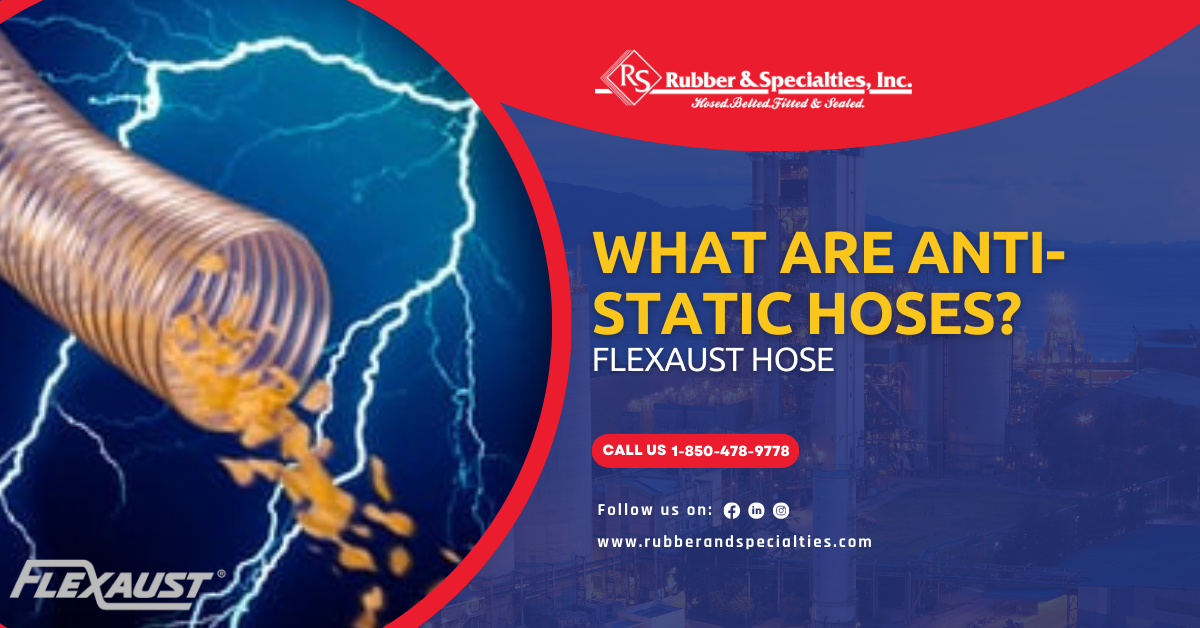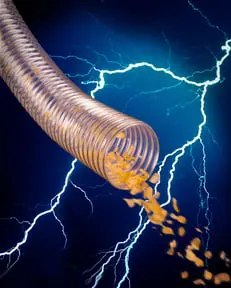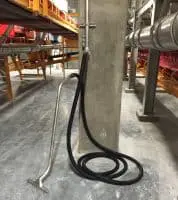
What are Anti-Static Hoses?
Many industrial sectors generate large volumes of fine dust particles. These flammable particle concentrations can be highly volatile in an enclosed area, combusting when in the presence of oxygen if they’re exposed to a spark, ember, or similar source of ignition. The potential for fires or even explosions means it’s critical for facilities with a high-risk factor to utilize anti-static hoses in their operations.
An anti-static hose can be one of two types: a static dissipative hose or a static conductive hose. Flexaust carries both types of anti-static hoses in a variety of lengths and materials, with designs suitable for a myriad of environmental and temperature requirements.
As a leading anti-static hose supplier, we provide products such as:
- Anti-static vacuum hoses
- Anti-static ventilation hoses
- Anti-static dust collection hoses
- Explosion-proof vacuum hoses
A closer look at each type of anti-static hose and the important roles they play will help to facilitate the appropriate selection.

How Does an Anti-Static Hose Work?
As materials like fine dust particles or wood chips pass through a hose, they can generate static electricity when they rub against each other or the hose walls. The particles touch and then move apart, transferring an electric charge between them. The friction these charged electrons generate can ultimately cause an electrostatic discharge, or that familiar shock sensation from static electricity, because there’s an electrical potential imbalance between the particles.
In industrial and manufacturing environments that create, transport, or process fine dust or powder, a seemingly innocuous static electricity spark can trigger explosions. Static will also result in materials clumping together, which can clog up your hose for reduced airflow and system performance. By using appropriate static dissipating hose materials and proper grounding during installation, durable and flexible anti-static hoses can sustain maximum airflow and keep static electricity from building up in the hose or its contents, mitigating the risk of these potential hazards.
What Makes a Hose Anti-Static?
For anti-static hoses, manufacturers carefully select materials that will offer characteristics best suited to a hose’s intended applications and installation environments. For example, it’s important to select a material with sufficient strength and weight for your needs as hose applications range from light- to heavy-duty. Other examples of desirable properties for anti-static hoses include:
- Conductive or dissipative capabilities, depending on the hose type
- Resistance to abrasion, tearing, crushing, chemicals, and corrosion
- Capability to perform in a wide temperature range
- Durability
- Good tensile strength
- Flexibility
- High vacuum tolerance
- FDA acceptable materials, if handling products like pharmaceuticals or consumables
- Antimicrobial properties
Anti-static hose materials will either be static dissipative or static conductive. The majority of our products are urethane with a static dissipative material. This allows non-conductive urethane to dissipate electrical charge safely while resisting tears, abrasion, and chemicals. Flexaust also offers a neoprene conductive hose, and this material is beneficial for its elasticity and conductive properties, as well as its thermal and chemical resistances.
Grounding is equally important in what makes a hose anti-static. As anti-static air hoses, material hoses, and related varieties will need to discharge static electricity, and because that process requires careful control, manufacturers typically integrate a grounding wire within the hose’s structure. This grounding wire provides a safe path for static electricity to follow, helping to prevent a dangerous buildup that could trigger painful shocks at best or catastrophic sparks at worst. Anti-static hoses and their conductive wires must be properly grounded to safely discharge electricity.
At Flexaust, some of our products decrease the amount of static build-up using an enclosed copper grounding wire. We also offer conductive PVC cuffs with the dual functions of providing superior anti-static protection and secure connections to your machinery. These cuffs make it possible for the grounding wire to achieve full contact with your vacuum equipment.
Static Dissipative Hoses vs. Static Conductive Hoses
Static dissipative and static conductive hoses perform the same job and produce the same result – that is, preventing the unwanted buildup of static electricity. How they go about it, however, is where the two anti-static hose types differ.
Hoses consisting of static conductive materials prevent static electricity buildup by providing less electrical resistance (higher conductivity) than surrounding components, essentially helping to draw the charge away through the hose, releasing it through proper grounding. Typical applications include industrial anti-static hose vacuums and woodworking setups.
Static dissipative hoses, on the other hand, achieve static elimination with a higher resistance hose material, meaning the electrical charge flows through a material in a controlled, slower manner. The material itself assists in static electricity prevention, spreading the charge out along the hose surface to keep any discharge from being great enough to result in ignition.
Applications of a Static Dissipative Hose
Often referred to as anti-static hose, the design of a static dissipative hose is to mitigate or prevent static electricity by dissipating it through the rubber material to the hose ends. Here are some of our static dissipative hoses and their most common applications:
- Flex-Tube PU 60 GV-GW: Grain vac, powder & bulk, static control
- FlexStat 80: Railcar loading/unloading
- Flex-Tube PV-SD-LW: Industrial vacuum cleaners, pharmaceutical, static control, woodworking/furniture
- Flx-Thane LD-SD: Applications requiring abrasion-resistance, dust collection, food-grade, static control, vapor recovery, woodworking/furniture
- Flx-Thane SD: Clean rooms, dust collection, fertilizer broadcasting, food-grade, glass clinching, granule transport

- FlexStat 60: Grain vac, plastic pellet transfer, powder & bulk, static control, surface prep dust collection
- FlexStat CR: Clean rooms, food-grade, pharmaceutical, plastic pellet transfer, powder & bulk
- FlexStat: Industrial vacuum cleaners, concrete floor cleaning, granule transport, injection molding, plastic pellet transfer, food-grade
Applications of Static Conductive Hoses
At Flexaust, we offer a variety of static conductive hoses, each suitable for specific application types:
- Flex-Tube PV-SC: Industrial vacuum cleaners, pharmaceutical, static control, woodworking/furniture
- StatPath: Auto tellers, bus ventilation, concrete floor cleaning, conduit, industrial vacuum cleaners, paper trim conduit, printing, sprayers, static control, ventilation

- StatPath Plus: Auto tellers, bus ventilation, concrete floor cleaning, conduit, industrial vacuum cleaners, paper trim conduit, printing, sprayers, static control, ventilation
- Conduct-O-Flex: Static control for dust and fumes
Why Anti-Static Hoses Are Important
Dust-ignition explosions are cause for concern in numerous industries nationwide. Unless businesses adhere to NFPA standard engineering regulations for static and dust management, they increase the risk of extensive property damage, not to mention worker injury or loss of life.
Though by no means a comprehensive list, applications with these environmental factors have a higher-than-normal risk of dust-related explosions:
- Agricultural dusts: Wet corn, sorghum, and other grains; sugar refining; flour and grain milling
- Carbonaceous dusts: Coal, graphite, grapheme, nano/mesoporous carbons
- Chemical dusts: NOC fatty acids, essential oils, gelatin
- Metal dusts: Milling, plating, polishing, anodizing, and coloring
- Plastic dusts: Synthetic resins and non-vulcanizable elastomers

Our anti-static dust collection hoses and static control hoses play a critical role in maintaining operational safety and preventing fires and explosions. We assist our clients in selecting flexible hoses with the best electrical resistance ratings and appropriate static control hoses to fit the unique risks associated with their facilities and operations.
SOURCE: https://blog.flexaust.com/blog/what-are-anti-static-hoses

